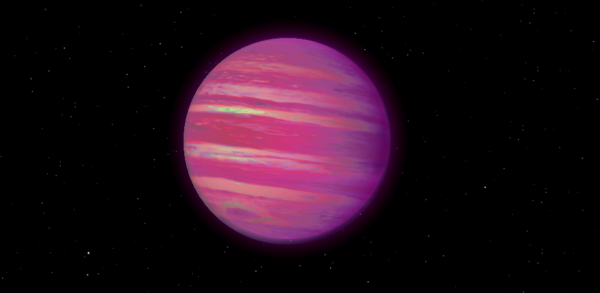BY LETTER
Sakura
Galactography > Regions of Space > Inner Sphere
Galactography > Systems and Worlds > Systems & Worlds S - T
Galactography > Systems and Worlds > Systems & Worlds S - T
 Image from Steve Bowers |
Location RA 13h16m46.51596s, Dec 09d25m26.9590s,
Distance from Sol 57.27 LY
spectral type G0V,
mass 1.22 x Sol
luminosity 2.148 x Sol
radius 1.258 x Sol
Teq = 6234 K, rotation period = 79.896 hours.
Sakura (59 Vir b):
Semi-major axis = 43.5 AU
mass = 4.0x Jupiter
radius = 115,117.669 km (1.61x Jupiter),
gravitational acceleration at the top of the atmosphere = 38.246 m/sec^2 (3.9g),
bulk density = 1188.444 kg/m^3
Teq = 510 K.
A young mesojovian orbiting 59 Virginis.
The planet is so young it is still emitting a noticeable amount of heat from its formation. Despite orbiting at a distance greater than that of Neptune from the Sol, Sakura has a temperature of 250*C. Due to atmospheric scattering, this gives the planet a deep purple hue overall. Located 47 light years from Sol, the system was colonized at the end of the Federation Era. Sakura proved difficult to colonize initially since the buildup of heat caused hemisphere wide atmospheric overturns that created massive storms. Particular attention had to be paid in designing bubble habitats that could navigate and operate comfortably in these conditions.
The planet's large radius is a consequence of its internal heat "puffing up" the atmosphere (an effect often observed in epistellar Jovians), implying that the radius will slowly contract as the planet cools. Another consequence of the planet's temperature is that the atmosphere is relatively cloudless and is relatively turbulent.
Because of its relative youth, Sakura has a greater amount of helium in its atmosphere compared to the Jovians of the Solar System. This star is relatively metal-rich ([Fe/H] = 0.28), and metal-rich stars tend to favor forming gas giant planets over smaller rocky worlds. The system is relatively free from dust and debris since the main period of protoplanetary formation period lies in the system's past, although some minor collisions have occured interior to Sakura's orbit in recent eras.
Appears in Topics
Development Notes
Text by Mark Ryherd
Radtech497
Initially published on 28 August 2013.
Radtech497
Initially published on 28 August 2013.






